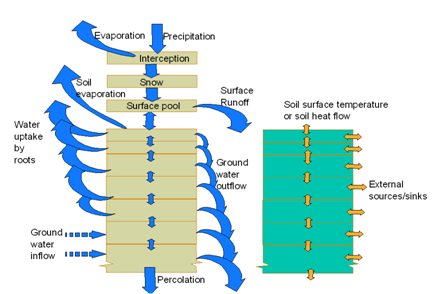Components of Water and Heat Processes

Figure 0.1. Mass balance (left) and heat balance (right) of the CoupModel.
The one dimensional CoupModel represents water and heat dynamics in a layered soil profile covered with vegetation. As the solution to model equations is performed with a finite difference method, the soil profile is divided into a finite number of layers. Compartments for snow, intercepted water and surface ponding are included to account for processes at the upper soil boundary. Different types of lower boundary conditions can be specified including saturated conditions and ground water flow (see switch GroundWaterFlow). Meteorological data are used as driving forces in the simulation and is given as measured or parameter values.
The water equation WaterEq and the heat flow equation HeatEq can be solved simultaneously or together. If only one is solved the other conditions are assumed as constants for the entire simulation periods. In such cases only initial values of these variables need to be considered.
Some options are linked to each other like the Evaporation and PlantType switches. The PlantType switch also differentiates between an explicitly expressed big leaf or explicitly expressed big leaves. The latter option allows the user to simulate several plants that will compete for radiation, water and nutrients. An overview on how some of the options and parameters affect each other are given in Appendix 1.
Several options are available for the soil water processes. Runoff can be included in the simulations as governed by the switch LateralInput. Soil water vapour flow can also be simulated (see switch SoilVapour).
Snow fall will affect both water and heat processes in many ways and can optionally be included in the simulations (see switch SnowPack).
The water and heat equations may be coupled in a dynamic way to the plant (i.e. accounting for feedback interactions between the plant and its environment) or the plant may be specified as given by driving variables or parameter values (see section Abiotic driving variables). This is determined by the switch Nitrogen and Carbon and the processes relating to nitrogen and carbon flows are described in detail in the section below.
Irrigation may optionally be included in the simulation (see switch Irrigation). A salt balance can also optionally be included (see switch SaltTracer).
The CoupModel can be run simultaneously with the soil chemistry equilibrium model, Minteq (see switch Minteq). More information on Minteq can be found on: http://www.lwr.kth.se/english/OurSoftware/Vminteq/index.htm.